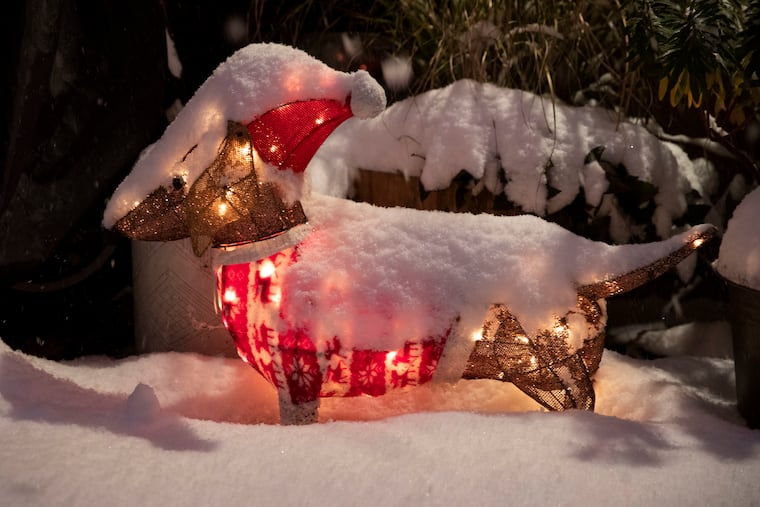Is Philadelphia going to have a White Christmas this year? The larger question is: Why do we care?
The image of snow and Christmas are enduring. The reality is something else altogether.

If you want snow on a Dec. 25, you probably wouldn’t want to be in Bethlehem, Israel — but in most years you wouldn’t fare much better in Philadelphia, New York, or Boston.
The cold reality is that a White Christmas would be a long shot even in places well-acquainted with winter snows. Bare ground around the time of the solstice is the rule for an overwhelming majority of Americans.
So if perchance snow is on the ground on Dec. 25 this year, consider it one of the more improbable events in what has been the year of the improbable
Yet Christmas snow is forever frozen in the American imagination. Just about every Christmas movie ever made has a requisite snow scene, however unconvincing. (A footnote: It’s a Wonderful Life actually was filmed during a heat wave, which is the reason Jimmy Stewart is sweating as he contemplates suicide.)
The odds against a White Christmas, loosely defined as an inch of snow on the ground on Dec. 25, are stacked 10-to-1 in Philadelphia, according to the National Centers for Environmental Information.
After the solstice it usually it takes awhile for the atmosphere to respond to the low sun angle and for the winter chill to ripen in the upper atmosphere, says Steve Decker, a meteorology professor at Rutgers University.
» READ MORE: How much snow for Philly this winter? After a bust year, TV meteorologists take their shots
It’s a long story
So what is behind this fixation with snow at Christmas? One person who dedicated time, energy, research, and intelligence to that overwhelming question was the late Tristram Coffin, a University of Pennsylvania folklorist and author of The Book of Christmas Folklore.
Coffin believes the seed of the concept was planted in Rome in the fourth century, during the reign of the emperor Diocletian and ripened in America in the 19th and 20th centuries. The tradition of “Santa Claus” was rooted in the legacy of the bishop of Myra, Nicholas, who died in 342 and later became St. Nicholas.
It is believed that he wore red robes — although keep in mind that Coffin was piecing together information from 17 centuries ago — and he is so depicted in images. The garments, by the way, appear more ecclesiastical and tasteful than the ones worn by the average department-store Santa, but, yes, they are a reddish color. St. Nicholas became revered in northern Europe, particularly in the Netherlands.
» READ MORE: Feds’ updated winter forecast favors warmth here and in most of the nation, especially December
On Dec. 6 every year, according to Dutch tradition, St. Nicholas would appear in the sky on a white horse, for whom children would leave hay in their wooden shoes.
The Dutch carried the tradition with them when they settled in New York Dutch country, and writer Washington Irving popularized the image of “Santa Claus” in a satiric poem. But it was another poem, credited to a professor of Greek and Oriental literature named Clement Clark Moore, that bound snow with Christmas with an immutable epoxy.
Dashing through the snow
The formal title of the poem was “An Account of the Visit of St. Nicholas,” and its authorship remains a subject of debate. It first appeared in 1823 in the Troy (N.Y.) Sentinel. Most people know it as “‘Twas the night before Christmas,” for one of the most famous first lines in all of literature. To the St. Nicholas narrative, the poem added reindeer and a sleigh that was the equivalent of a 19th-century pickup truck brimming with gifts.
Troy, in the Upper Hudson Valley, is one of the places where a snow cover at Christmas is a reasonable possibility. Those “clipper” systems barreling eastward from southwestern Canada sometimes pass over that area, and the region is close enough to the Atlantic for nor’easter impact, yet far enough away to evade the warming impact of onshore winds that change snow to rain along the coastal plain.
» READ MORE: Much has changed in 2020. The magic and mystery of snow persist. | Book Excerpt
And back then, a Christmas snow cover would have been all the more likely. That was the twilight of the “Little Ice Age,” an era dating to the Renaissance when Europe, northeastern North America, and perhaps other parts of the planet were significantly colder than they are today.
Another rather famous individual writing not long after that was one Charles Dickens. In A Christmas Carol, snow adds more than a dash of atmosphere.
The Christmas-snow connection was solidified in the 1942 with Bing Crosby’s rendering of “White Christmas” in Holiday Inn.
That was followed a decade later by the movie that iced the bond between Christmas and snow in America: White Christmas.